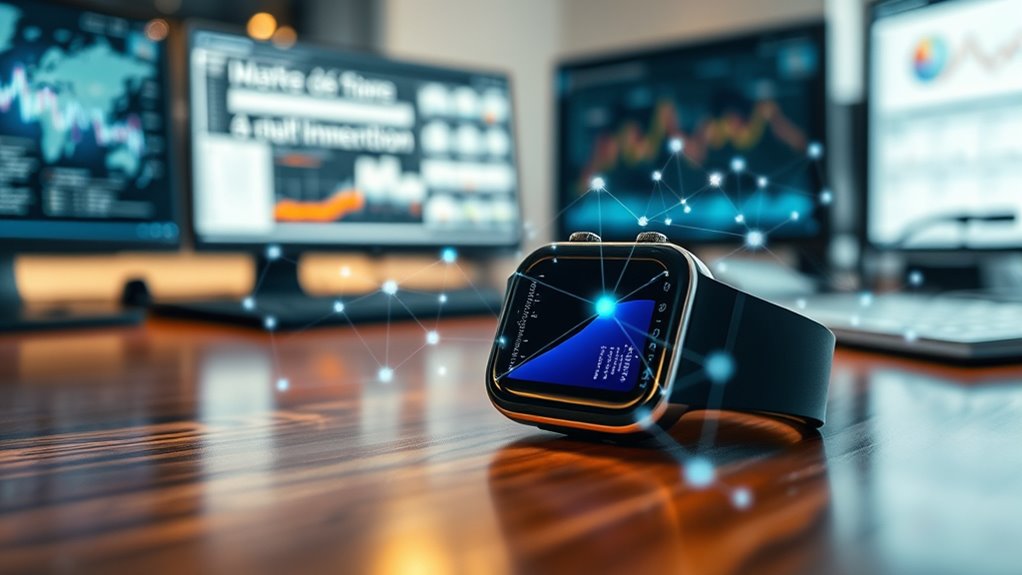Federated learning lets your health gadgets improve their models by working together without sharing your personal data. Devices train local models and send only updates to a central server, keeping your information private. This approach boosts privacy, reduces data transfer, and enables personalized healthcare solutions. However, challenges like data differences and communication costs exist. If you keep exploring, you’ll discover how this technology shapes the future of secure, smart health devices.
Key Takeaways
- Federated learning enables health gadgets to collaboratively train models without sharing sensitive raw data.
- Devices locally process data and send only model updates to protect patient privacy.
- The central server aggregates updates to improve the shared health model iteratively.
- This approach reduces data transfer risks and maintains data confidentiality in healthcare applications.
- Challenges include data heterogeneity, communication costs, and ensuring privacy against potential leaks.
What Is Federated Learning and How Does It Work?

Federated learning is a machine learning technique that allows devices to collaboratively train a shared model without sharing their raw data. Instead of uploading sensitive information, your device trains a local model using its own data. Once training is complete, it sends only the model updates—like learned patterns—to a central server. The server then aggregates these updates from multiple devices to improve the overall model. This process repeats iteratively, with each device refining its local model based on the latest version. By doing so, federated learning keeps your personal data private while still contributing to a powerful, collective model. This method is especially valuable in healthcare, where data privacy is critical but collaborative insights can considerably improve diagnostics and treatments. For example, in health gadgets, comprehensive coverage options can ensure that devices handle various health conditions effectively without risking patient confidentiality.
Benefits of Using Federated Learning in Healthcare Devices

One of the key advantages of using federated learning in healthcare devices is that it enhances patient privacy without sacrificing the quality of insights. Instead of transferring sensitive data, models learn locally, reducing exposure risks. This setup allows you to keep personal health information secure while still gaining valuable insights for better diagnoses and treatments. Additionally, federated learning speeds up the development of machine learning models by enabling multiple devices to collaborate simultaneously. It also reduces the need for centralized data storage, cutting costs and minimizing data breach vulnerabilities. Furthermore, understanding the fundamental principles of sound design can inspire innovative approaches to data visualization and user interface design in healthcare technology.
Challenges and Limitations of Federated Learning in Health Gadgets

While federated learning offers significant benefits for health gadgets, it also faces several challenges that can hinder its effectiveness. One major issue is data heterogeneity, where data across devices varies greatly, making it difficult to develop a unified model. Additionally, communication costs can be high, as devices need to frequently exchange updates with the central server, draining resources and impacting performance. Privacy concerns also persist; despite local data staying on devices, model updates can sometimes leak sensitive information. Furthermore, ensuring all devices participate consistently is tough, especially when some have limited processing power or unreliable connections. These challenges highlight that, while federated learning is promising, addressing technical and logistical obstacles is essential to fully realize its potential in healthcare applications. Understanding emotional support can also enhance how we approach challenges in implementing such technology effectively.
Real-World Examples of Federated Learning Applications

Despite the challenges faced by federated learning in health gadgets, real-world applications are already demonstrating its potential to improve patient care and device performance. For example, some hospitals use federated learning to develop personalized models for predicting patient deterioration without sharing sensitive data. Wearable device companies leverage it to enhance activity recognition algorithms, ensuring better accuracy across diverse users. Additionally, federated learning helps optimize insulin pump algorithms, maintaining privacy while improving glucose management. As the technology advances, understanding the regional legal resources involved in healthcare data sharing becomes increasingly important.
The Future of Privacy-Preserving Health Technology

How will privacy evolve as health technology becomes more integrated into our daily lives? You’ll see a shift toward even stronger privacy measures, driven by advancements like federated learning and secure multiparty computation. These innovations allow your devices to analyze health data locally, sharing only insights rather than raw data. As technology advances, you’ll benefit from personalized health insights without sacrificing confidentiality. Future health gadgets will likely incorporate multi-layered encryption and transparent data management policies, giving you more control over your information. Privacy-preserving techniques will become standard, fostering trust and wider adoption of health tech. Additionally, understanding the role of contrast ratio in device displays can help you select gadgets that maintain visual clarity while preserving data privacy. Ultimately, these developments aim to balance innovation with your right to privacy, ensuring your health data remains safe while enabling smarter, more responsive healthcare solutions.
Frequently Asked Questions
How Does Federated Learning Compare to Traditional Centralized Data Models?
You might wonder how federated learning differs from traditional centralized data models. Unlike centralized models that gather all data in one place, federated learning keeps your data on your device, sending only model updates to a central server. This approach enhances privacy and reduces data transfer. It allows your health gadget to collaborate on improving algorithms without exposing sensitive information, making it a safer, more efficient way to learn from your data.
What Are the Hardware Requirements for Implementing Federated Learning in Health Gadgets?
Did you know that implementing federated learning in health gadgets requires devices with at least a quad-core processor and 2GB of RAM? You’ll need hardware capable of local data processing and model training without relying on constant internet access. Devices should also have secure storage and encryption capabilities to protect sensitive health data. Ensuring these specifications helps maintain efficiency, privacy, and accuracy in federated learning applications.
How Is Data Security Maintained During Model Updates?
During model updates, you guarantee data security by using encryption techniques like secure multi-party computation and differential privacy. These methods protect individual data points from exposure, even during model aggregation. You also implement strict access controls and regular security audits to prevent unauthorized access. By doing so, you keep sensitive health data safe, maintaining privacy and trust throughout the federated learning process.
Can Federated Learning Adapt to Rapid Changes in Health Data?
You wonder if federated learning can adapt quickly to rapid health data changes. It’s designed to update models locally on devices, then share only the updates, not raw data. This allows the system to learn from new patterns efficiently. While there’s some delay in aggregating updates, ongoing improvements in algorithms help federated learning respond faster, making it suitable for dynamic health environments where data changes happen swiftly.
What Are the Potential Regulatory Hurdles for Deploying Federated Learning in Healthcare?
You might face regulatory hurdles when deploying federated learning in healthcare, like ensuring data privacy and security compliance, such as GDPR or HIPAA. Authorities may require transparency about how models learn from sensitive data. Additionally, there could be challenges around standardizing protocols and validating model accuracy. Managing these regulations calls for thorough documentation, robust security measures, and collaboration with regulators to ensure your implementation meets all legal and ethical standards.
Conclusion
As you explore federated learning in health gadgets, remember it’s like having your own sci-fi sidekick—protecting your data while still learning from it. Though it faces hurdles, its potential to revolutionize healthcare privacy is immense. Embrace the future, where even a 21st-century “cybersuit” can keep your health info safe while delivering smarter, personalized care. So, stay curious—this tech is just getting started, and the best is yet to come!









